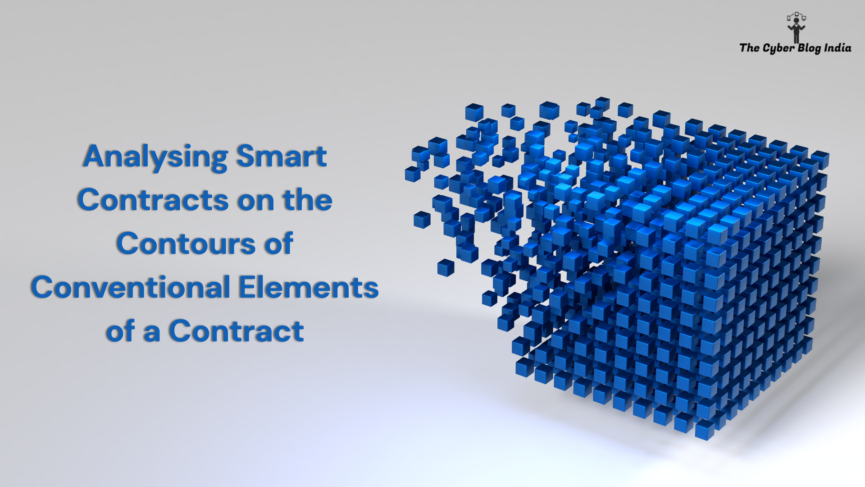Analysing Smart Contracts on the Contours of Conventional Elements of a Contract

All of us must have played an online game or two in our lifetime. Some would have made several in-game purchases. If not that, I am sure you would have traded cryptocurrencies or NFTs. However, have you ever wondered how these in-game purchases, or buying and selling of blockchain-based assets, actually work? At the core of these transactions lie smart contracts. They are essentially the consensus between parties executed by a computing system. Unlike traditional contracts, smart contracts are free from intermediaries like brokers and legal representatives. Best of all, they are entirely automated. In this article, we explore what smart contracts are and how they stand on the contours of traditional elements of a valid contract.
Decoding Smart Contracts
Smart contracts are self-executing agreements wherein the agreement between parties gets directly translated into lines of code. A smart contract ecosystem uses blockchain to store and execute smart contracts, ensuring security and transparency. Their key characteristics include:
-
Automation: Immediate execution of transactions on the fulfilment of pre-defined conditions.
-
Third-party involvement: Absence of intermediaries to moderate and define the terms of the contract.
-
Decentralisation: Distributed control across the network permits seamless transactions between parties without any single third party’s control or influence.
As complex as they may seem, smart contracts only work on a simple logic of if/when-then. Here, a smart contract performs and executes specific actions upon the fulfilment and verification of predetermined conditions. To understand a smart contract’s logic, consider a sale of an NFT between a buyer and seller. This would translate to: If and when the buyer transfers the agreed payment, the automated code would transfer the NFT to the buyer’s account. Essentially, the automated code identifies the buyer’s payment and transfers the said digital asset to their account. Simultaneously, it updates all relevant databases to reflect this transaction.
Elements of a Valid Contract
In India, the Indian Contract Act, 1872 provides for the essentials of a valid contract. These essentials include:
-
Offer and its subsequent acceptance being conveyed to the party
-
Free consent for the contract without any coercion, undue influence, fraud, misrepresentation, and mistake (Section 14)
-
Competency of the parties to enter into a contract (Section 11)
-
Lawful consideration and object (Section 23)
-
Not against law, public policy, or of an immoral nature
Contracts are agreements enforceable by law. Agreements that satisfy these requirements are considered a contract, as a general principle of law.
Legal Recognition of Smart Contracts
Successful enforcement of a contract stands as its ultimate purpose. However, the big question is whether smart contracts will receive legal recognition under existing laws. At present, we can only analyse their validity by determining how they satisfy the essentials of a valid contract.
In terms of offer and acceptance, a smart contract comes into existence only when both parties convey their intention and consent for the contract. When it comes to free consent, the parties’ conduct can demonstrate their consent to engage in the transaction. With the help of digital verification and authentication, competency of parties can be established. However, for lawful consideration and object, a system of checks and balances is necessary to prevent illegal and unlawful activities.
Hence, smart contracts can satisfy general essentials of a valid contract, provided there are checks and balances to ensure the lawfulness of object and consideration. If this happens, smart contracts can receive recognition by virtue of Section 10A of the Information Technology Act, 2000 which validates contracts formed through electronic means. While this is a hopeful situation, the reality is a little different from this. The judicial system, particularly in India, has remained silent on the topic. This has left transacting parties with little to no room for recourse or remedies for contractual breach.
Conclusion
Smart contracts mark the advent of technological advancement in the legal system, the leap of law in the realm of digital transactions with unparalleled transparency and efficiency, all guaranteed by automation. Though not without its own limitations, this revolutionising technology, despite the simple “if/when-then” logic, has effectively catered to the challenges associated with traditional contracts and provided a more feasible and practical solution. Nonetheless, even if smart contracts may not fully replace traditional contracts yet, their usage in the current status quo is irreplaceable. As Joseph Krutch has put:
Technology made large populations possible; large populations now make technology indispensable.
